Here we present a mosaic introduction of winners for the 2020 Tan Kah Kee Science Awards as well as Tan Kah Kee Young Scientist Awards (TKK Awards) as released on Augusts 28. This special coverage includes a brief overview of the TKK Awards (go here for detail) and a total of 11 reports zooming in onto respective awardees, as reviewed here below.
TKK Science Award in Mathematics and Physics
Experimental Discoveries of Pentaquark States

An event of the new decay pathway recorded by the Large Hadron Collider beauty (LHCb), the decay from a bottom baryon to charmonium quarks, protons and exotic mesons. (?CERN)
Physicists have long been wondering whether or not hadrons could be formed by five quarks – in other words, whether or not there exist pentaquark states. The quark model does not exclude such possibilities, yet for over five decades, no sign of such exotic states has been detected, despite the persistent efforts contributed by scientists across the world. Scientists did find hundreds of hadrons in cosmic rays or collider experiments, including different mesons that commonly each consist of a quark and an anti-quark, and baryons that each contain either three quarks or three anti-quarks; however, they never beheld any pentaquark hadron. Such exotic hadrons, if exist, might inspire further understanding of the strong force, the least understood among the four very basic forces underlying our cosmos.
A team of Chinese physicists working on the LHCb experiment at the European Organization for Nuclear Research (CERN)’s Large Hadron Collider changed the game. Led by CAS Member GAO Yuaning, the team focused on a new decay pathway previously discovered in the LHCb experiment and delved into the massive data of about 26,000 cases of such decay events. They eventually detected “something exotic” – and this discovery earned their project the TKK Science Award in Mathematics and Physics.
For the story, please click here.
TKK Science Award in Chemical Science
New Privileged Chiral Ligand for Catalytic Asymmetric Reactions
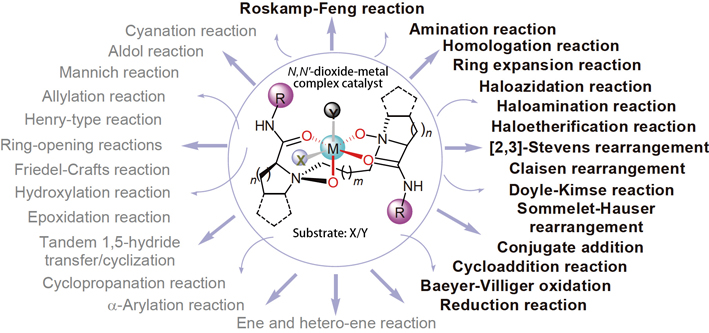
Representative asymmetric reactions catalyzed by chiral N,N’-dioxide-metal complexes, in which many new or challenging reactions are shown in black bold. (Image by FENG’s Lab)
Catalysts and ligands possessing the great ability to tolerate a wide range of mechanistically unrelated reactions are spoken of as ‘privileged’, which are rather scarce but extremely valuable in catalytic asymmetric synthesis. Notably, almost all the formerly reported privileged chiral ligands/catalysts share relatively rigid conformations, and, by default, having a chiral ligand of rigid conformation was considered as a prerequisite to be a privileged chiral ligand/catalyst.
Jumping outside of the box, CAS Member Prof. FENG Xiaoming and his coworkers have developed a new library of conformationally flexible, N,N'–dioxide amide compounds with original design and featured structure (named as Feng ligand now). Chiral N,N'–dioxide has found widespread applications in asymmetric catalytic reactions, including many new or challenging reactions that are hard to achieved before. Therefore, the TKK Science Award in Chemical Science went to FENG for his important contributions to chirality science.
For more detail, please refer to the report here.
TKK Science Award in Life Sciences
Splicing Cycle Visualized in Atomic Detail

Pre-mRNA splicing is essentially a ‘molecular surgery’ on the pre-mRNA performed by a large molecular machinery called spliceosome. (Image by SHI’ Lab)
Pre-mRNA splicing, the removal of non-coding introns and ligation of coding exon by a large molecular machinery called spliceosome, is an essential step in gene expression. The splicing process is highly dynamic, and one little mistake may cause human genetic disease.
To gain insights into how the splicing machinery changes over the course and gets the job done, CAS Member Prof. SHI Yigong and his coworkers sought to capture snapshots of the splicing machinery when it splices a simple pre-mRNA molecule (two exons spaced by one intron). These snapshots, put in the right order, form a choreography that, as illustrated, allows us to appreciate the dynamic process of pre-mRNA splicing.
For more details, please refer to the report here.
TKK Science Award in Earth Sciences
Destruction of North China Craton
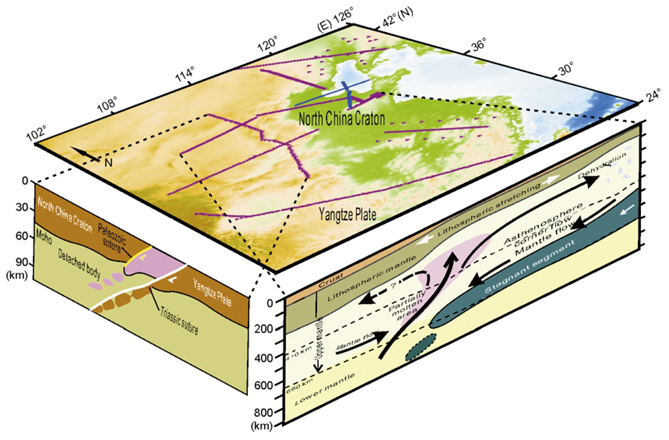
Deep processes as illustrated by studies on crust-upper mantle structure in the North China Craton. (Zhu R X, Xu Y G, Zhu G, et al., 2012)
A common understanding about cratons, the most ancient part of lithospheric continents, is their signature stability: generally, geological activities are scarce within a craton. The North China Craton (NCC), however, represents an exception. Evidence shows that in this region, particularly its eastern part, the strata endured large-scale geological activities during the Mesozoic, including intense magmatism and mountain building. What has driven this drastic change? This bears global importance and means a lot in continent formation as well as evolution.
To unravel this enigma, researchers led by CAS Member ZHU Rixiang conducted large-scale interdisciplinary investigations and analyses, and their long dedication has borne fruits. Subverting traditional understanding, this school of geologists and geophysicists proposed a brand-new theory concerning the destruction of NCC. The TKK Science Award in Earth Sciences went to this feat.
For detail, click here.
TKK Science Award in Technological Sciences
Can Friction Disappear?

Model of superlubricity. (Image by LUO’s Lab)
Reportedly, friction accounts for one third of the fuel consumption in automobiles and friction-caused wear significantly reduces the lifetime of mechanical parts. Finding ways to reduce friction and wear, and even make them disappear is thereby persistently pursued by scientists to save costs and improve industrial safety.
To this end, CAS Member Prof. LUO Jianbing and his coworkers resort to superlubricity, a lubricating state in which friction almost vanishes completely. Through decades of explorations, they have achieved superlubricity using many different liquids as lubricants and proposed that the mechanism of liquid superlubricity can be, as illustrated, attributed to hydration force, electric double layer force, and hydrodynamic effects.
For more detail, please refer to the report here.
TKK Young Scientist Award in Mathematics and Physics
Solutions of Demailly’s Strong Openness Conjecture and Related Problems in Several Complex Variables
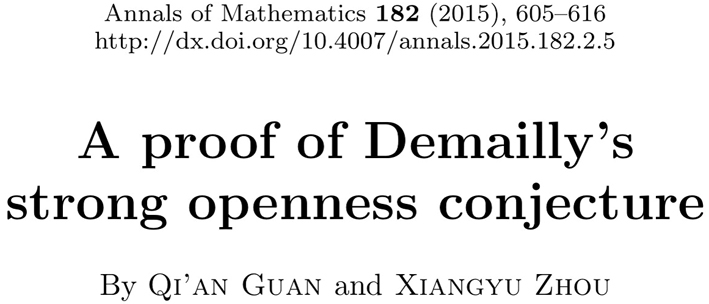
The TKK Young Scientist Award in Mathematics & Physics went to Prof. GUAN Qi’an, a young talented mathematician from Peking University, for his solutions of a series of problems in several complex variables, particularly for his proof of the Demailly’s strong openness conjecture, which was marked by a paper entitled “A proof of Demailly’s strong openness conjecture” published in the prestigious Annals of Mathematics in 2015.
“In the reviewer’s opinion, the proofs of both the openness and the strong openness conjectures,” commented the Mathematical Reviews, “are among the greatest achievements in the intersection of complex analysis and algebraic geometry in recent years.”
For the full story, please turn to page 152.
TKK Young Scientist Award in Chemical Science
Deciphering the Sweet ‘Dressing Code’ on Cells
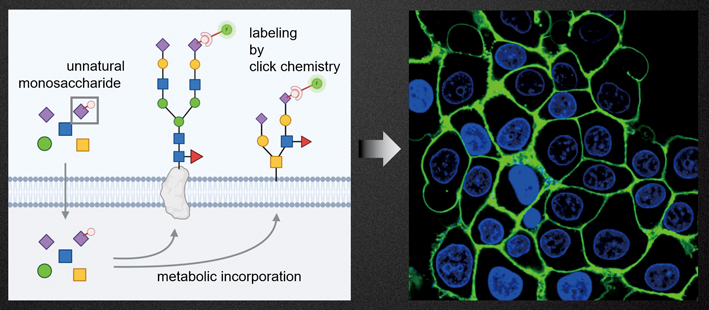
Lighting up the cell-surface sugars by metabolic glycan labeling. (Image by CHEN’s Lab)
Cell-surface sugars, or glycans, take the shape of trees and play important roles in many aspects of life. Different cells host different types and abundance of glycans, and even one same cell abides by different ‘dressing codes’ in order to cope with different scenarios.
To decipher the sweet “dressing code” on cells, Prof. CHEN Xing and his coworkers from Peking University have developed specific widgets to chemically label cell-surface sugars, which subsequently can be studied for various purposes, apart from simply lighting them up.
To savor the full piece, please refer to the report here.
TKK Young Scientist Award in Life Sciences
Fixing Hybrid Vigor by Making Clonal Seeds

The hybrids (left) appear the same, while their offspring (right) are quite different in many ways, such as growth rate, fitness and yield. (Image by WANG’s Lab)
Hybrid vigor is a phenomenon in which hybrid offspring are superior to either of their parents in many aspects and has thereby been exploited by breeders to produce many elite crops, including the well-known “three-line” and “two-line” hybrid rice.
There is, however, a big problem for these hybrid crops: You can’t keep seeds from the hybrids. Because the seeds harvested from these elite hybrids would grow into different plants. It seems that, as illustrated, things would turn out differently for their offspring, which was caused by ‘genetic segregation’, a phenomenon shared by all sexually-reproducing organisms in spreading their genes. Because of that, the breeders must produce the hybrid seeds year by year, which is a very laborious and of high cost.
To circumvent this underlying mechanism of sexual reproduction, Prof. WANG Kejian and his coworkers have achieved clonal reproduction of hybrid rice through seeds, which thereby opens a new route to fix hybrid vigor and one day may spare the trouble of repeatedly making the hybrid seeds each year.
For the full story, please refer to the report here.
TKK Young Scientist Award in Earth Sciences
Are Soil Desiccation Cracks Mostly in Square Shape, or Hexagon?
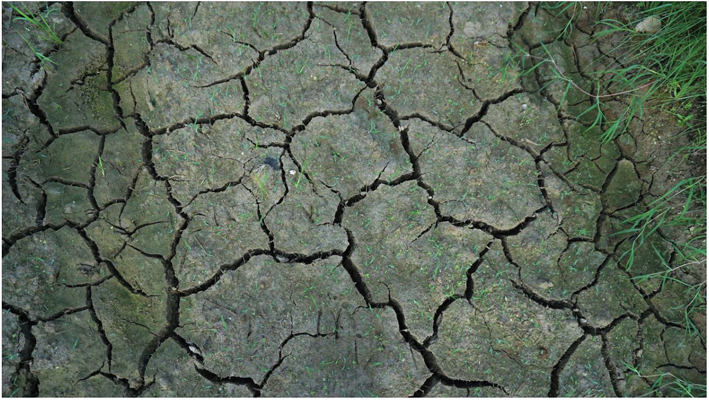
Soil desiccation cracks in the field. (Image by Pixabay)
The TKK Young Scientist Award in Earth Sciences went to Prof. TANG Chaosheng for his important contributions to drought-related engineering geology, particularly in developing an artificial climate simulation system that has been used to study the behaviors of drought-induced soil desiccation cracking.
TANG’s study on soil desiccation cracking started around twenty years ago, when, one day, his supervisor came to him with a question – Are the soil cracks mostly in square shape, or hexagon?
“Since then, I embarked on the road of ‘mud-playing’, and there is no turning back,” recalled TANG in a public talk after receiving the Award.
To find out more, please refer to the report here.
TKK Young Scientist Award in Information Technological Sciences
Harnessing Chaos to Control the Momentum of Light

(Image by the courtesy of Yin Feng and Xuejun Huang)
The TKK Young Scientist Award in Information Technological Sciences went to Prof. XIAO Yunfeng, a physicist from Peking University, for his achievements in micro-cavity optical physics and devices.
XIAO and his collaborators found an innovative way, by deforming the shape of an optical whispering-gallery-mode (WGM), to create and harness so-called chaotic channels that can be used to control the momentum of light.
As illustrated, coupling the optical fields from waveguides to the optical fields in WGM in photonic circuits is like trying to transfer a package between a bike and a car on a highway. Without the chaos, coupling photons to an optical mode is inefficient (left). With the chaos, the photons could be efficiently delivered to the optical mode (right).
For detail, please refer to the report here.
TKK Young Scientist Award in Technological Sciences
Forging the Great by the Smalls

The route of metal additive forging technology that can forge the great by the smalls. (Image by SUN’s Lab)
When you walk into power plants, you will find yourself surrounded by all sorts of bulky metal components (rotors, turbine runners, and pressure vessels etc.). These bulky metal pieces, or heavy forgings, play indispensable roles in modern industry and usually serve under harsh conditions.
Traditional heavy forgings, made by pouring melted metals of more than 100 tons into a big pot and allowing it to solidify slowly, usually born with defects, and the larger the ingot, the more severe the defects. These defects in heavy forgings, like cancerous cells within a normal tissue, can dramatically deteriorate a forging’s mechanical property and thereby cut down its service life, thus posing a worldwide challenge for manufacturing high-quality heavy forgings.
To jump out of the box, a research team led by Prof. SUN Mingyue at the CAS Institute of Metal Research (IMR) first put forward a novel technology, which is termed additive forging, to manufacture high-quality heavy forgings. Inspired by the architecture, the additive forging technology uses small building blocks to form the great, like using the bricks to build The Great Wall.
For detail, please refer to the report here.

